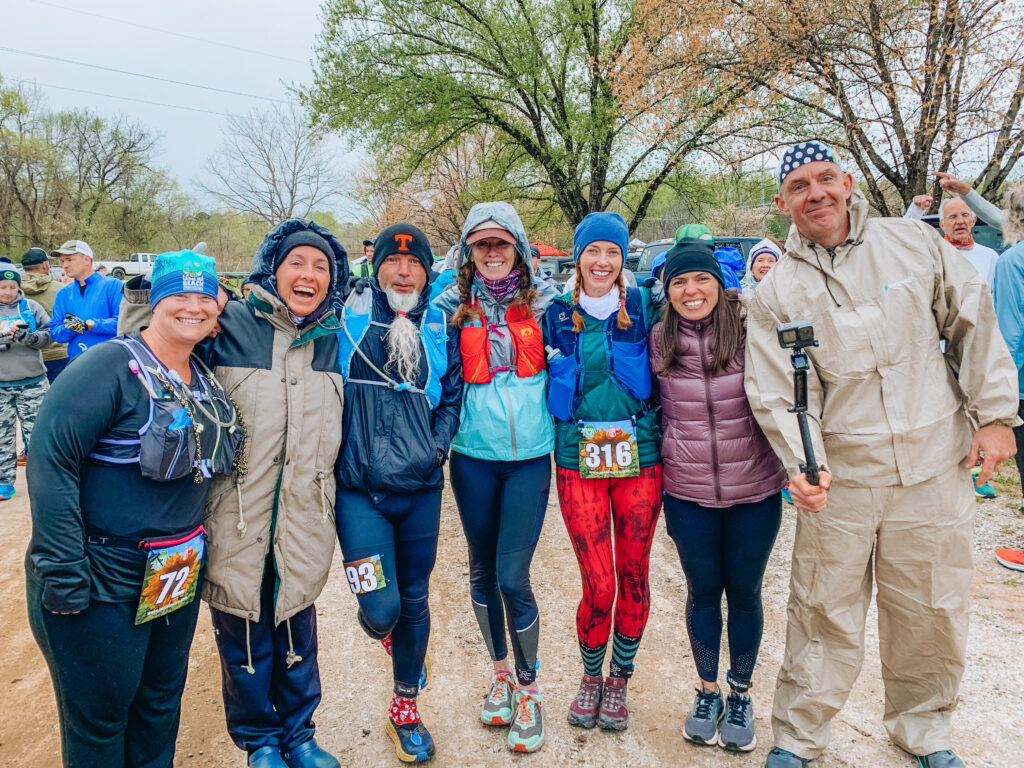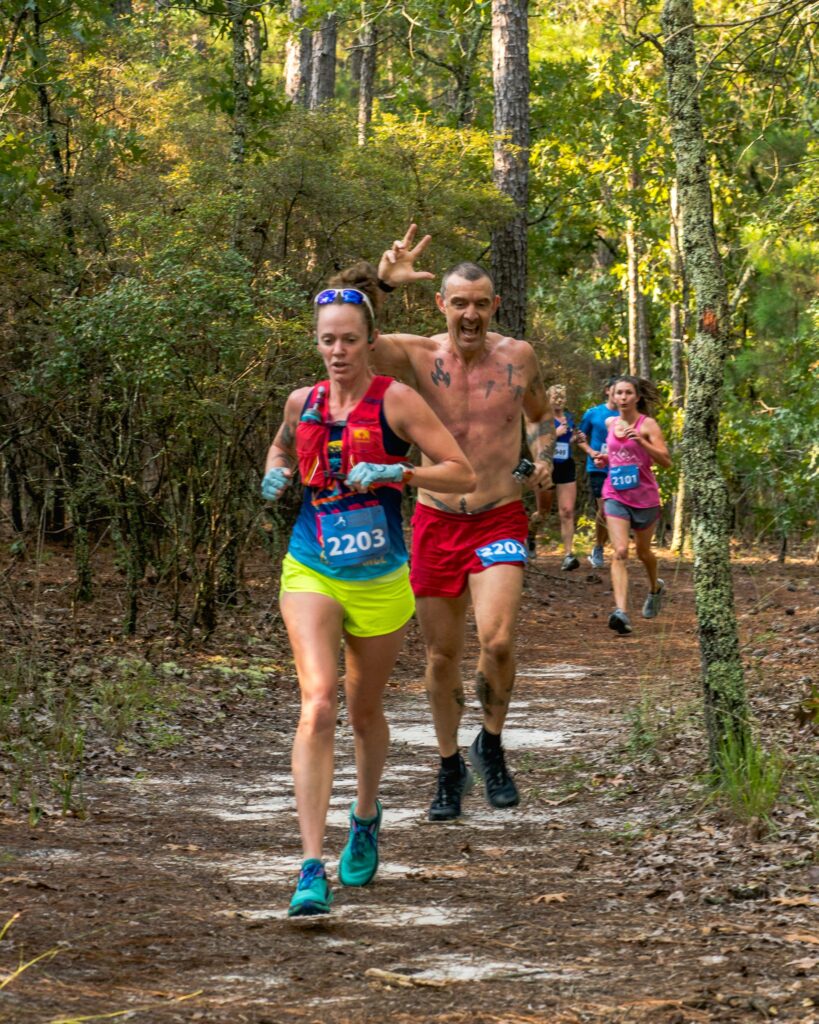Last Updated on December 6, 2023 by Heather Hart, ACSM EP, CSCS
Burnout is a term often thrown around in the endurance racing community to describe athletes who have been training too hard, racing too much, and generally doing a poor job of balancing high levels of physical and emotional stress with much needed rest.
Burnout is also a term we hear repeatedly in the work force, describing when someone is in a a state of excessive emotional, mental, and physical exhaustion brought on by prolonged or repeated job stress.
In classic “let me make all the mistakes and write about it so you don’t have to” form, today I want to talk about how to prevent burnout as a running coach (or as a coach in general). Whether you coach full time or part time as a “side hustle”, it’s easy to unknowingly put yourself at risk for experiencing burnout as a running coach.

If you’re new here, let me introduce myself: I’m Heather, an exercise physiologist, CSCS, and RRCA & UESCA certified running coach. I’ve been working in the fitness industry as a personal trainer since 2010, and began my career as a running coach in 2015. In 2017 my husband and I created Hart Strength and Endurance Coaching, and I’ve been coaching full time ever since…
…except for the brief period I spent so utterly burnt out on the industry, that I had to take a step back.
Yes, that’s right. At one point during my career I moved all of my clients to other coaches, temporarily closed my roster, and took a break from coaching. In doing so, I was able to pinpoint a number of mistakes I was making and poorly established boundaries on my part that likely led to the burnout in the first place. Identifying these problems allowed me to eventually return to coaching with a more healthy mindset.
I also quickly realized that this is a topic rarely discussed in the run coaching industry. Likely because the virtual coaching business is still a relatively new market. But also because there’s a ton of vulnerability in admitting that you need (or needed) a break. It doesn’t look good for your business, I’ll be the first to admit that.
But, if I’ve established one thing over the last 14 years of writing here at Relentless Forward Commotion, it’s that I am an open book, unafraid of vulnerability, especially if it helps others. So on both a personal and professional level, I’m happy to share what I learned during my time off from coaching, in hopes that it will help other run coaches avoid falling into the pits of “burnout” themselves.
Here we go:
Establish (and Adhere to) Working Hours
One of the perks of working as an online running coach is that you can work pretty much whenever and wherever…but that doesn’t mean you have to.
When you are first starting a run coaching business, you may be so hyped up on providing an incredibly positive experience for your clients that you feel the need to stop whatever you’re doing, at any time of day, to tend to an athletes needs. And while this is understandable, it’s simply not realistic nor sustainable…especially long term.
Think about it: almost every other business on the planet (short of 24/7 grocery stores and emergency rooms) will have clearly established business hours. And you, as a business, should too.
Just because you work virtually and almost always have a phone or laptop at your disposal, does not mean you have to be available 24 hours a day.
Even though you gave an athlete your phone number, you are not obligated to respond if they send a text at 11:00 pm when you’re already curled up in bed.
Just because coaching is your “dream job” doesn’t mean you can’t take time for yourself.
You can still offer unlimited communication and be readily available to your clients, while establishing and maintaining boundaries that will protect your personal time.
By setting these working hours – and adhering to them- from the start, your athletes will hopefully learn to also respect your working hours (and not get into the habit of texting you at 11:00 pm, expecting an immediate reply).
Let Clients Know How to (and How Not to) Get in Touch with You
In addition to available working hours, let your athletes know right away the best place to communicate with you regarding coaching matters.
When we first started Hart Strength and Endurance Coaching, I’d communicate with athletes over seemingly every platform available. Facebook messages? Sure! Text message? Why not! Carrier pigeon? We love birds!
But this quickly backfired in more than one way:
- I have (diagnosed) ADHD, and without keeping all of my coach-athlete communications in one place, I would sometimes forget to respond, forget to check in the first place, or drop the ball on important information.
- It started to feel like there was no work/life boundary with my social media usage. For example, if I wanted to cut back on my own social media consumption, I couldn’t, because I would always have to keep tabs on my personal (not business) profile inboxes just incase an athlete was trying to get in touch with me.
- When I had a death in the family and had to unexpectedly take a few weeks off from coaching, I was fortunate to have Geoff help me with programming. However, with athletes communicating with me all over the place, he didn’t know where to find important information regarding that athlete’s needs, nor how to get in touch with them.
By asking my athletes to communicate with me regarding coaching matters on very specific platforms (for me it’s email, via Final Surge comments or messages, or by requesting a Zoom or phone meeting), I was able to cut back on incessantly checking every social media platform under the sun, and worrying that I might have missed something important.

Don’t Be Afraid to Set Relationship Boundaries
Years ago I took the RRCA Run Coaching certification course in person (back before we all learned how to Zoom). I will never forget the instructor telling us that our coaching relationship with our clients needed to be 100% professional, and that we should never talk about anything OTHER than running with our athletes.
While I agree the coaching/client relationship SHOULD always remain professional, I will call bullshit on the “never talking about anything other than running” with my runners. Because as a coach – especially one who coaches ultramarathon athletes – I want to know what’s going on in my clients lives (to an extent) in order to best help them balance their training with “life”.
I want to know if work is demanding overtime hours and they are physically and mentally stressed out over it, so we can adjust their training load accordingly.
I want to know if an athlete is feeling down/angry/not themselves, as it might be a sign of low energy availability or overtraining.
While I don’t need to know the details, it helps to know if a client is suddenly going through a divorce or breakup, as it may explain why they haven’t been motivated to do their workouts (or alternatively, are suddenly running all of their workouts way too hard/too fast.)
But where it becomes blurry is when an athlete is repeatedly spending your hour zoom calls together venting about how their husband tries to sabotage their long runs, or when a client constantly leaves post workout comments about how their current performance leaves them feeling worthless as a human.
These types of situations are not only uncomfortable, but can leave you dreading working with a particular client. Not to mention, helping with these situations is wildly out of your scope of practice as a running coach.
So while I do believe you can be friends with your clients (some of my clients have become wonderful friends!) it’s important that you also set up professional relationship boundaries when it comes to your coaching.
Do not be afraid to redirect the conversation when necessary, or blatantly say “I’m not comfortable talking about this, can we stick to running please?” if necessary.
Further, do not be afraid to suggest they speak to a mental health counselor if needed (which was ultimately what I did with both of the examples I mentioned above).
Get Comfortable Saying “I Might Not Be the Best Coach for You.”
Way back when I first started working in the fitness industry, I lacked confidence in my abilities. I naively believed that a “good coach” would have all of the answers and be able to do anything. Naturally, I pretended there was nothing I couldn’t handle.
This resulted in things like:
- Agreeing to help a woman train for the Tevis Cup (that’s the Western States 100 but with a horse) when I didn’t know the first thing about horses, never mind running or training with one.
- Agreeing to take on a triathlete client, even though I wasn’t a triathlon coach. She told me she’d take care of the swimming, if I took care of the rest. We made it work, but it left me constantly worrying that the programming wasn’t lining up.
- Misquoting which races were in the Grand Slam of Ultras and looking like an idiot to a client inquiring if I could help her run those races.
- Letting a client who was trying to calorie count (on her own, I wasn’t prescribing a diet nor giving nutrition advice) but was too overwhelmed to use the MyFitnessPal app, text me photos of her meals, so I could enter the food into the app for her.
- Promising to text an athlete EVERY SINGLE MORNING to make sure she got up and did her workout, because she lacked motivation to do it herself.
- Not saying “that’s a horrible idea, and I don’t want to be a part of it” to a client who insisted on maintaining her running streak, even though she was perpetually injured and could never seem to progress to her distance goal.
These are just a few examples of situations I agreed to where the athlete would have likely had greater success (and I would have had far less stress) if I had referred them to a coach who would have better suited their particular needs…or simply said “no thank you, this doesn’t feel like a good fit for me as a coach/this isn’t what I offer”.
While taking on new-to-you-challenges can help you grow as a coach, there is absolutely zero shame in saying that something is out of your scope of knowledge or comfort as a coach.
Have a Healthy Relationship with Running.
Chances are you became a running coach because you love running. Unfortunately there may come a time when running is not the center of your universe, for whatever reason. It may be due to an injury or other unforeseen circumstance, and hopefully it’s temporary.
But I can tell you from experience – when you suddenly find yourself unable to run, and you have nothing else in your life to fall back on that brings you joy, you’ll feel devastated.

I realize how dramatic that sounds – but I’ve also been around runners long enough to know that for the majority of the running population, it’s true.
It’s not uncommon for runners in this situation to want to distance or remove themselves entirely from the conversation around running until they can run again. It makes them jealous, or breaks their heart to see other people talk about running when they, themselves, cannot currently run.
When you’re a running coach with paying clients, you simply cannot distance yourself from the sport because your own runner heart is broken.
You still have to talk about running – it’s now your job. And if you don’t have a healthy relationship with running yourself, this forced “talking about running” may leave you feeling downright resentful, which is not at all fair to your clients.
As the saying goes – you cannot help others if you can’t help yourself first. If you truly want to become a professional, career long coach, make sure your own relationship with running is in check.
Know Your Roster Limits
At the end of the day, as much as we claim to “love coaching” we are also in this for the money. The reality is, we all have bills to pay. So once the inquiries start rolling in, it can be very hard to turn anyone away, and tempting to collect that monthly coaching fee to try and make ends meet.
Don’t do it.
Over-fillng your roster and taking on too many clients will not only stress you out as a coach, but it will absolutely water down your coaching services and ability to effectively communicate and coach your clients. You’ll constantly feel as though you’re never caught up and you’re not doing enough…because you aren’t.
Do not take on more clients than you can REALISTICALLY handle, despite the temptation. It’s bad for your business, it’s bad for your clients, and it’s bad for the coaching community as a whole.
Outsource or Automate as Much as Possible
As mentioned at the very start of this article, one of the perks of working as an online running coach is that you can work pretty much whenever and wherever…especially when you are self employed.
But having the freedom to do “whatever” can often lead to added stress when there is no consistency.
- Outsource what you can, when you can, so you can focus on coaching as much as possible (tax preparation, website design and maintenance, marketing, etc.)
- Get in the habit of following a schedule. For example, letting your clients know that you’ll be responding to workout comments on Mondays and Wednesdays, making programming adjustments on Tuesdays and Thursdays, etc. Know you’ll be working on marketing and billing on Fridays. There’s no right or wrong here, the point is, having a schedule and sticking to it will help keep you from feeling overwhelmed.
- Automate everything you can: billing, social media posts, newsletters, etc.
As the saying goes, “work smarter, not harder”.
Take Days Off
“Hustle culture” has us believing that working endlessly without taking time for ourselves is the only way to succeed. I highly disagree. Your business will thrive and you will become a better coach when you take time off to do the things you love to do outside of coaching.
Again, just because you love what you do doesn’t mean you have to be available 24/7.
Have a Support System
Lastly, find yourself a support system of fellow coaches who completely understand what you are going through.
Working virtually can be very isolating. And working in an industry where you feel like you are constantly competing for new clients can feel cutthroat.
For a long time I felt this way, constantly comparing myself to other coaches and feeling as though they were all the “competition”. It drove me crazy.
Ultimately I chose to take the “A rising tide lifts all boats” approach. Yes, other coaches are in theory “my competition”, but by working together we can not only better ourselves as coaches, but raise the bar of the coaching industry as a whole.
Networking, joining coaching mastermind groups, and mentoring other coaches – even if they don’t end up working for my business – has helped me grow as a coach. And I encourage you to do the same.
Further, having a network of coaches will allow you to refer out when you encounter a potential client that is not the right fit for you (see above). In turn, those coaches may send athletes your way when they feel you’d be a better fit. It’s a win for everyone involved!
Final Thoughts:
Burnout is one of those things that you often don’t realize is even a possibility until you’re in the midst of it. I am in no way an expert when it comes to running a business, and I’m certainly not telling you how to run yours. However, if I could go back in time and tell younger-coach-Heather anything, it would be
- Believe in yourself and your abilities, but also learn when to say “no”.
- Set boundaries early and often: those that cannot respect them are not the right fit for you and your business
- And lastly, when you start to feel more than just a little stressed, and begin to question whether or not this is the right career for you: STOP. Take a step back, reach out for support, and reevaluate BEFORE you crash-and-burn.
I hope you found this post helpful. And if you have anything to add with your own burnout experience as a coach, feel free to leave comments below!
Heather Hart is an ACSM certified Exercise Physiologist, NSCA Certified Strength and Conditioning Specialist (CSCS), UESCA certified Ultrarunning Coach, RRCA certified Running Coach, co-founder of Hart Strength and Endurance Coaching, and creator of this site, Relentless Forward Commotion. She is a mom of two teen boys, and has been running and racing distances of 5K to 100+ miles for over a decade. Heather has been writing and encouraging others to find a love for fitness and movement since 2009.

Leave a Reply